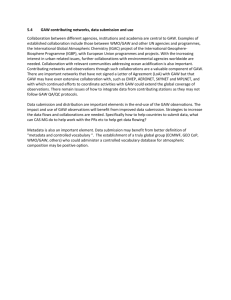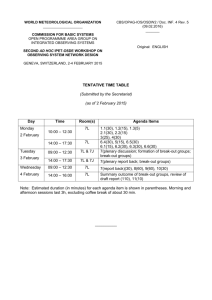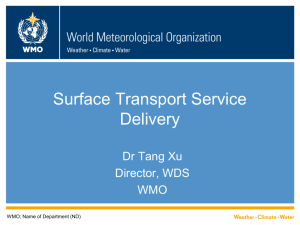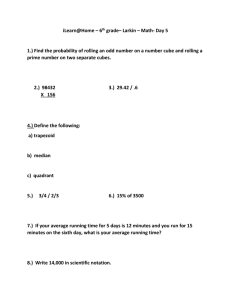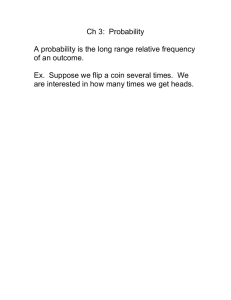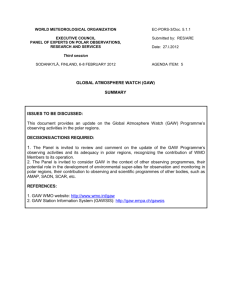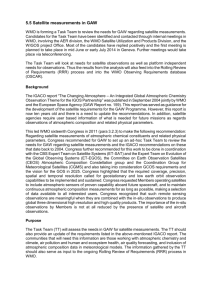QA/QC and Rolling Review of Requirements
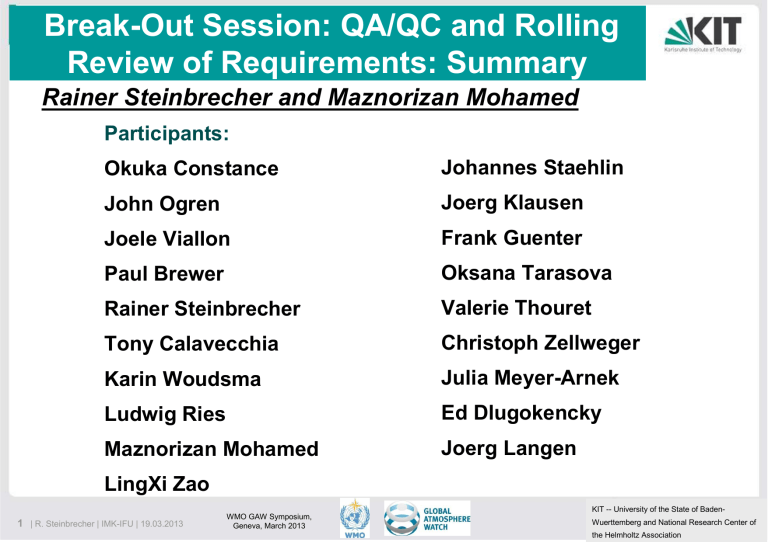
Break-Out Session: QA/QC and Rolling
Review of Requirements: Summary
Rainer Steinbrecher and Maznorizan Mohamed
Participants:
Okuka Constance Johannes Staehlin
John Ogren Joerg Klausen
Joele Viallon Frank Guenter
Paul Brewer Oksana Tarasova
Rainer Steinbrecher Valerie Thouret
Tony Calavecchia Christoph Zellweger
Karin Woudsma Julia Meyer-Arnek
Ludwig Ries Ed Dlugokencky
Maznorizan Mohamed Joerg Langen
LingXi Zao
1 | R. Steinbrecher | IMK-IFU | 19.03.2013
WMO GAW Symposium,
Geneva, March 2013
KIT -- University of the State of Baden-
Wuerttemberg and National Research Center of the Helmholtz Association
Break-Out Session: QA/QC and Rolling
Review of Requirements: Summary
Questions addressed:
Definition of Data Quality Objectives: Where to go?
What are the connections between DQOs and user requirements?
How to formulate platform independent user requirements?
What is the observational capacity and where are the gaps?
How efficient is the current GAW QA/QC system?
2 | R. Steinbrecher | IMK-IFU | 19.03.2013
WMO GAW Symposium,
Geneva, March 2013
KIT -- University of the State of Baden-
Wuerttemberg and National Research Center of the Helmholtz Association
Break-Out Session: QA/QC and Rolling
Review of Requirements: Summary
Data quality Objectives (DQOs)
DQOs are qualitative and quantitative statements that clarify the objectives of observations, define the appropriate type of data, and specify tolerable levels of uncertainty.
DQOs will be used as the basis for establishing the quality and quantity of data needed to support decisions.
NOTE
DQOs will be used inter alia as a basis to support decision makers as well as to support assessments as observational evidence (e.g. inventories, model output, satellite retrievals).
In order to enhance the DQOs it is important to take into consideration user field requirements.
3 | R. Steinbrecher | IMK-IFU | 19.03.2013
WMO GAW Symposium,
Geneva, March 2013
KIT -- University of the State of Baden-
Wuerttemberg and National Research Center of the Helmholtz Association
Break-Out Session: QA/QC and Rolling
Review of Requirements: Summary
Rolling Review of (user) Requirements (RRR): Definitions
The user requirements are not system dependent, they are intended to be technology free.
The “goal” is a maximum requirement.
The “threshold” is the minimum requirement that has to be met to ensure that data are useful.
The “breakthrough” is an intermediate level between
“threshold” and “goal“ which, if achieved, would result in a significant improvement for the targeted application.
4 | R. Steinbrecher | IMK-IFU | 19.03.2013
WMO GAW Symposium,
Geneva, March 2013
KIT -- University of the State of Baden-
Wuerttemberg and National Research Center of the Helmholtz Association
Break-Out Session: QA/QC and Rolling
Review of Requirements: Summary
Rolling Review of (user) Requirements (RRR):
Define user requirements (e.g. scientific community
(e.g. modelling, satellite, agricultural, environmental, air quality, communities), politics, and public as a summary of user cases.
Requirements should be discussed in detail and then defined in the corresponding SAGs.
SAGs should “translate” user requirements into technical requirements to the observing system.
5 | R. Steinbrecher | IMK-IFU | 19.03.2013
WMO GAW Symposium,
Geneva, March 2013
KIT -- University of the State of Baden-
Wuerttemberg and National Research Center of the Helmholtz Association
Break-Out Session: QA/QC and Rolling
Review of Requirements: Summary
Observational capacity and gaps
GAW Focal Areas:
Aerosols
No obvious gaps for current focal areas identified.
The role of oceans?
Greenhouse Gases
Reactive Gases
Ozone
UV Radiation
Precipitation Chemistry
Observational capacity and gap analysis for focal areas should be conducted in the specific
SAGs.
GURME
6 | R. Steinbrecher | IMK-IFU | 19.03.2013
WMO GAW Symposium,
Geneva, March 2013
KIT -- University of the State of Baden-
Wuerttemberg and National Research Center of the Helmholtz Association
Break-Out Session: QA/QC and Rolling
Review of Requirements: Summary
Efficiency of the current GAW QA/QC system
At present the performance of the GAW QA/QC system is excellent compared to other WMO programs.
The development of documents for measurement guidelines is on the track.
Activities to link the GAW Scale to international accepted reference materials (BIPM) has been launched and will be continued.
Activities to transfer the scale to regional calibration centres need to be fostered.
7 | R. Steinbrecher | IMK-IFU | 19.03.2013
WMO GAW Symposium,
Geneva, March 2013
KIT -- University of the State of Baden-
Wuerttemberg and National Research Center of the Helmholtz Association
